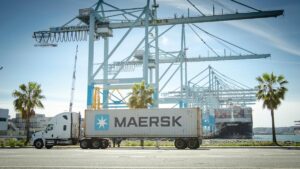Chart of the Week: Analyzing Outbound Rail Container Volumes
Focus on Los Angeles: As we delve into the latest data from the Outbound Loaded Rail Container Volume for both international and domestic markets, the insights are clear. The Outbound Tender Volume Index (OTVI) for Los Angeles and its neighboring Ontario region reveals encouraging trends amidst some looming challenges.
Intermodal demand is surging in the Los Angeles market, significantly increasing its market share against the ailing truckload sector. Los Angeles, the principal U.S. entry point for goods from Asia, is poised to be the first area where the ramifications of new tariffs become apparent. However, current domestic freight patterns remain unchanged, though changes are on the horizon as we track this evolving landscape.
The Dominance of L.A. Ports
The California ports of Los Angeles and Long Beach collectively administer about 32% of all container imports into the U.S., dwarfing the second-ranking port complex of New York and New Jersey, which handles roughly 15%. This staggering statistic underlines the immense role Los Angeles plays not only in freight movement but also in warehousing, further establishing its position as the leading outbound transportation hub.
By scrutinizing intermodal container volumes alongside truckload demand, we illuminate how tariffs might trigger shifts in transportation trends and consumer behavior nationwide. Shipping containers, sized for international use, serve as a convenient option for moving goods inland efficiently. However, logistics often dictate that these containers are repurposed into domestic formats or palletized for truck transport, evidently complicating the picture.
Future Expectations Amid Tariff Concerns
As companies grapple with the implications of tariffs, particularly on Chinese imports, recent data suggests we might soon witness a sharp decline in container volumes arriving from China. The SONAR’s Ocean Booking Volume Index indicates that bookings for twenty-foot container equivalents have tumbled around 45% in recent weeks, forecasting potential supply disruptions within the month. This preemptive signal should prompt all investors and businesses to evaluate their strategies critically.
On the flip side, many companies are not sitting idle; they have proactively started sourcing from alternative suppliers in countries like Vietnam and Thailand. While these alternatives don’t wholly match China’s production capabilities, they are poised to soften the impact of possible trade imbalances.
Building Resilience in Supply Chains
The lessons learned from the COVID-19 pandemic have inspired many companies to enhance their supply chain resilience. Firms have begun stockpiling inventories, often maintaining a safety net that can extend beyond a month. This strategic positioning can potentially buffer against short-term import disruptions from China and provide the breathing room needed for negotiations or new supply agreements.
The Risks of Whipsaw Effects
However, this newfound inventory could create a “whipsaw” effect. Should a trade resolution materialize, the sudden influx of orders may become unmanageable, straining existing transportation networks. Thus, the significance of maintaining operational readiness cannot be overstated. The current volatility suggests that transportation providers must develop a flexibly responsive operational strategy to meet sudden demand spikes.
The Short-Term Outlook
In the near term, we may see truckload freight experience a surge due to the urgency to replenish decreasing inventories. Yet, without a shift towards longer-term restocking behavior, this uptick could prove to be fleeting. The uncertainty of the present climate makes forecasting exceedingly difficult, calling for all players in the transport ecosystem to prepare for rapid shifts.
Data and Insights for Future Navigation
Understanding how these elements interconnect is crucial. The insights drawn from resources like the FreightWaves SONAR provide invaluable real-time data to help stakeholders navigate this complicated landscape effectively. These curated charts serve not only to visualize market trends but also to guide strategic decision-making under pressure.
From tracking outbound volumes to anticipating changes driven by tariffs, organizations must be agile, insightful, and ready to pivot as the economic landscape evolves. Subscribers to SONAR benefit from a comprehensive understanding of the shifting dynamics at play. Engage with this information now to stay ahead in a volatile market!

